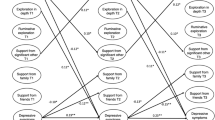Abstract
Theoretical assumptions outlined by Erik Erikson on psychosocial crisis resolution hypothesizes that the positive resolution of the identity crisis is predictive of more mature intimacy formation. To test this hypothesis, college-aged late adolescents (48 subjects) completed interviews and selfreport instruments measuring identity formation and degree of intimacy along with daily records of social interactions for one week. Analyses indicated a complex association between identity and intimacy formation. Comparisons were made between the exploration and commitment process of identity and the measures of intimacy formation and social interaction measures. Numerous complex sex differences were observed with several interactions between gender, exploration, commitment, and intimacy context. Findings are discussed in terms of broadening future research direction beyond the simple study of the linkage of identity and intimacy.
Similar content being viewed by others
References
Adams, G. R., and Gullotta, T. (1983).Adolescent Life Experience. Brooks/Cole, Monterey, CA.
Adams, G. R., Shea, J., and Fitch, S. A. (1979). Toward the development of an objective assessment of ego-identity status.J. Youth Adoles. 8: 81–89.
Bourne, E. (1978a). The state of research on ego identity: A review and appraisal. Part I.J. Youth Adoles. 7: 223–251.
Bourne, E. (1978b). The state of research on ego identity: A review and appraisal. Part II.J. Youth Adoles. 7: 371–392.
Douvan, E., and Adelson, J. (1966).The Adolescent Experience. John Wiley & Sons, New York.
Erikson, E. H. (1963).Childhood and Society. Norton, New York.
Erikson, E. H. (1968).Identity: Youth and Crises. Norton, New York.
Erikson, E. H. (1980).Identity and the Life Cycle. Norton, New York. [Originally published, 1959].
Erikson, E. H. (1982).The Life Cycle Completed: A Review. Norton, New York.
Fitch, S. A., and Adams, G. R. (1983). Ego-identity and intimacy status: Replication and extension.Develop. Psychol. 19: 839–845.
Gilligan, C. (1982).In a Different Voice. Harvard University Press, Cambridge, MA.
Grotevant, H. D., and Adams, G. R. (1984). Development of an objective measure to assess ego identity in adolescence: Validation and replication.J. Youth Adoles. 13: 419–438.
Grotevant, H. D., Thorbeck, W., and Meyer, M. L. (1982). An extension of Marcia's Identity Status Interview into the interpersonal domain.J. Youth Adoles. 11: 33–48.
Hodgson, J. W., and Fischer, J. L. (1979). Sex differences in identity and intimacy development in college youth.J. Youth Adoles. 8: 37–50.
Josselson, R., Greenberger, E., and McConochie, P. (1977a). Phenomenological aspects of psychosocial maturity in adolescence. Part I. Boys.J. Youth Adoles. 6: 25–56.
Josselson, R., Greenberger, E., and McConochie, P. (1977b). Phenomenological aspects of psychosocial maturity in adolescence. Part II. Girls.J. Youth Adoles. 6: 145–165.
Kacerguis, M. S., and Adams, G. R. (1980). Erikson stage resolution: The relationship between identity and intimacy.J. Youth Adoles. 9: 117–126.
Marcia, J. E. (1966). Development and validation of ego-identity status.J. Personal. Social Psychol. 3: 551–558.
Marcia, J. E. (1980). Identity in adolescence. In Adelson, J. (ed.),Handbook of Adolescent Psychology. John Wiley & Sons, New York.
Milardo, R. M. (1982). Friendship networks in developing relationships: Converging and diverging social environments.Social Psychol. Quart. 45: 162–172.
Newman, B. M., and Newman, P. R. (1978). The concept of identity: Research and theory.Adolescence 13: 157–166.
Orlofsky, J. C. (1976). Intimacy status: Relationship to interpersonal perception.J. Youth Adoles. 5: 73–88.
Orlofsky, J. L., Marcia, J. E., and Lesser, I. M. (1973). Ego identity status and the intimacy versus isolation crisis of adulthood.J. Personal. Social Psychol. 27: 211–219.
Raphael, D. (1977). Identity status in university women: A methodological note.J. Youth Adoles. 6: 57–62.
Read, D., Adams, G. R., and Dobson, W. R. (1984). Ego-identity status, personality, and social influence style.J. Personal. Social Psychol. 46: 169–177.
Reis, H. T., Wheeler, L., Spiegel, N., and Kernis, M. H. (1982). Physical attractiveness in social interaction: II. Why does appearance affect social experience?J. Personal. Social Psychol. 43: 979–996.
Russell, D., Peplau, L. A., and Cutrona, C. E. (1980). The revised UCLA Loneliness Scale: Concurrent and discriminant validity evidence.J. Personal. Develop. 39: 472–480.
Sullivan, H. S. (1953).The Interpersonal Theory of Psychiatry. Norton, New York.
Tesch, S. A., and Whitbourne, S. K. (1982). Intimacy and identity status in young adults.J. Personal. Social Psychol. 43: 1041–1051.
Waterman, A.S. (1982). Identity development from adolescence to adulthood: An extension of theory and a review of research.Develop. Psychol. 18: 341–358.
Wheeler, L., and Nezlek, J. (1977). Sex differences in social participation.J. Personal. Social Psychol. 35: 743–754.
Wheeler, L., Reis, H., and Nezlek, J. (1983). Loneliness, social interaction, and sex roles.J. Personal. Social Psychol. 45: 943–953.
Author information
Authors and Affiliations
Additional information
Partial funding for this study was provided through a grant to the second author. Support was given by Science and Education Administration/United States Department of Agriculture and the Utah State Agricultural Experiment Station.
Research interests include adolescent development, personality and social relations, and mental health issues.
Research interests focus on personality and social development in adolescence.
Research interests include psychotherapy, mental health, and psychopathology.
Rights and permissions
About this article
Cite this article
Craig-Bray, L., Adams, G.R. & Dobson, W.R. Identity formation and social relations during late adolescence. J Youth Adolescence 17, 173–187 (1988). https://doi.org/10.1007/BF01537966
Received:
Accepted:
Issue Date:
DOI: https://doi.org/10.1007/BF01537966




